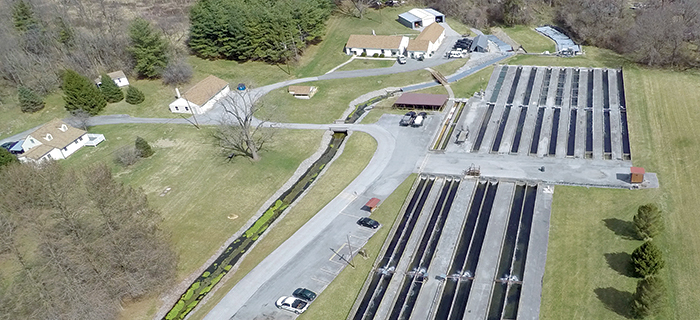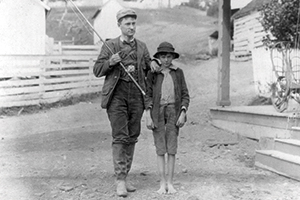Natural History: Centuries of Maryland conservation laws in one document

Albert Powell Hatchery; by Jim Thompson
In 1967, a retired Maryland fisheries manager felt compelled to tell the full history of fishing regulation in the Old Line State. Albert Powell wrote a 369-page report with the weighty title and subtitle, “Historical information of Maryland Commission of Fisheries, with some notes on game: Based on Annual Reports, legislative enactments and personal observations; also the compiled laws of the Game and Inland Fish Commission, 1654-1965.”
In his introduction to the publication, Powell describes the exhaustive research of records, legislation and governor’s actions that dated back to the founding of the colony.
Powell worked in the state’s freshwater fish programs for over 40 years and briefly for the U.S. Bureau of Fisheries. In recognition of his service and contributions, particularly to the state’s freshwater fisheries programs, the state renamed its largest fish hatchery after him, the Albert N. Powell State Fish Hatchery in Washington County.
What he found was that fish and wildlife managers since colonial times have contended with the same issue, balancing enjoyment of Maryland’s bounty with the need to conserve it for future generations.
“Very early in Maryland’s harvest of game and fish, it was found necessary to enact laws for their protection. The first enactment was made in 1654, twenty years following the settlement of Maryland,” Powell wrote.
“The early inhabitants of Maryland soon learned that the ruthless destruction of the seemingly inexhaustible number of fish called for protection and a law was passed in 1696 ‘prohibiting the striking of fish during the upstream migration.’”

Anglers in 1896; courtesy of State Archives
“As years followed, the need for the protection of fish became more evident, so much so, that by 1874 a body of persons introduced a bill in the Maryland General Assembly creating the Maryland Commission of Fisheries, and appointed two individuals—one from the Western Shore and one from the Eastern Shore, to administer the affairs in the interest of food fish in particular.”
Other excerpts of Powell’s manuscript give details of how Maryland’s early government conserved both wildlife and their ecosystems.
“Predators, such as wolves, foxes and crows, were of much concern and bounties were paid for killing them. Squirrels seemed to be considered a predator too, due to their destructiveness to crops. Bounty on wolves continued into the early 1800s.”
To pay for the bounties, counties taxed the residents in pounds of tobacco, “(two) to 20 pounds by each taxable person … collected by the sheriff and, in turn, paid out on bounties for the various animals killed… in lieu of paying tax in tobacco, each person was required to produce squirrel scalps and 5 crow heads for each taxable person; such person falling short, a levy of 2 pounds of tobacco to be exacted and collected by the sheriff.”
Maryland’s state law books record the first deer season in 1730, stating: “For the preservation for the breed of deer, no person within the province (friendly Indians exempted) shall kill any deer between the first day of January and the last day of July. Penalty, 400 pounds of tobacco—one-half to be paid to county schools and one-half to the informer.”
Later, Powell notes, “It became necessary to restrict the killing of deer for three years, beginning 1775, and the season was September and October.”
Moving into the 19th century, Marylanders continued to moderate methods of hunting and fishing as they impacted the environment.
In 1768, “the preservation of fish was brought into legislation and prohibited dams or other forms of structures that would prevent free passage up and down stream. The obstruction of passage has caused much concern over the years and a law covering this is on the statute books today.”
“In 1810, Baltimore County made it prohibitive to use quicklime to destroy fish. Quicklime was used in several ways to capture fish; one was to mix the lime with water and pour this into the stream, This would affect the gills of the fish and cause death very soon after contact. Another form was to partly fill a container with lime, add water, seal the lid and place container underwater. Gas would form from the mixture and cause an explosion, killing the fish.”
Jumping ahead, Powell records a timeline, seen below of ongoing, organized efforts at controlling and conserving various wildlife from the lands and waters of Maryland, leading up to his contemporary times.
Powell’s report is one of myriad publications the department will be moving to the electronic archives of the Enoch Pratt Free Library, the public library system of the City of Baltimore.
Anyone who wishes to see the full scanned version of Powell’s book can contact customerservice.dnr@maryland.gov.
Article by Gregg Bortz—Office of Communications chief public information officer. Appears in Vol. 22, No. 1 of the Maryland Natural Resource magazine, winter 2019.



 1-888-373-7888
1-888-373-7888 233733
233733